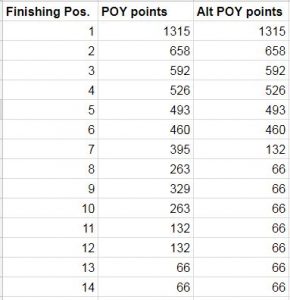At the start of the 2018 World Series of Poker (WSOP), it looked like Joe Cada was the early favorite to win Player of the Year honors. After all, he started with a ninth-place showing in the $10,000 Super Turbo event before June was even underway. Then, the very next day, he won the $3,000 NLHE Shootout. He captured his third career WSOP bracelet and also pocketed a $226,000 payday.
Then, as is often the case as the WSOP runs on into the summer, other contenders emerged. Players like John Hennigan and Eric Baldwin combined a bracelet win with a host of other cashes to climb to the top of the leaderboard. Unlike every WSOP dating back to 2000 though, there was no clear-cut two-time bracelet winner.
After starting strong, Cada finished even stronger
In the final week of play though, we didn’t just get one two-time winner, we got three. Shaun Deeb and Justin Bonomo both earned two, though Bonomo’s One Drop victory did not factor into POY standings.
And then there was Cada. Not only did he win two bracelets, he also finished fifth in the second-largest Main Event in history. Cada started with a bracelet, then ended with another in the massive-field Marathon event. Just two days removed from his $2.15 million Main event score, he picked up his fourth bracelet and over $660,000.
Certainly, the game of poker is about winning and money. It is about beating tough competition too. Nonetheless, with cashes in both the Colossus and the Millionaire Maker, it is difficult not to be impressed by how many entries he outlasted. Across seven cashes, he bested 31,818 entries. That’s an average field size of 4,545.
We’ve laid out the case for Cada, but even without the numbers, it seems pretty clear: he was absolutely the WSOP Player of the Year. So, why then, is he third in the POY standings?
New POY formula trying to address issues of the past
One has to commend the WSOP for never resting on its laurels when it comes to Player of the Year. The organization has frequently changed formulas. Both BLUFF Media and GPI operated the formula in the past. For the past two years, the WSOP has powered the formula in-house. BLUFF’s major critique was it overvalued high buy-in events over large fields with smaller stakes. GPI was similarly criticized for undervaluing the marquee events like Colossus but massively overvaluing the Main Event.
In 2017, the formula seemed to be deeply rooted in return on investment. As such, players like the eventual winner Chris Ferguson earned plenty of points for frequent cashing. Meanwhile, players with only a handful of cashes were too far back in the standings to contend. Case in point: David Bach. The only two-time bracelet winner of the summer finished the race 86th in the standings.
To their credit, the WSOP continued to tinker and introduced an entirely new formula this year. It isn’t something we have never seen before though. It is actually modeled after the points system the WSOP Circuit uses to determine which players qualify for the Global Poker Championship freeroll.
Essentially there are four tiers of points:
- Final table
- 20 percent of the remaining players who cash
- The next 30 percent of the remaining players who cash
- All remaining in-the-money players
The best part of all? First place is heavily weighted. With first getting almost double the points of second, the likelihood a double bracelet winner tops the ranks is higher. And, indeed, that is the case this year, as Deeb is currently in first place in the standings.
This is all well and good, but the problem remains–why is Joe Cada third with more money earned than the players in front of him?
Why the WSOP favors Deeb and Yu over Cada
Looking through Cada’s score, one thing immediately jumps out, and that is his Main Event finish isn’t worth all that many points. It is comparable to the points Ben Yu got for finishing as runner-up in the $25,000 PLO event.
This is not necessarily a bad thing. Previous systems, BLUFF in particular, put so much weight on the Main Event that the winner would automatically be in the top ten even if they did not cash in anything else.
Moreover, it isn’t like Cada gets points for difficulty for making the final table for a second time. It is a great story, but it doesn’t, nor should it, count for added points.
By and large, Cada’s points seem to jive though, so the next place to look is the results of Deeb and Yu, the players ahead of him in the standings.
Yu has 14 eligible cashes with four final table appearances and one bracelet. Most of his deep runs are in higher buy-ins. He won his bracelet in the $50,000 event and finished runner-up to Deeb in the $25,000 PLO.
Deeb’s numbers are similar. Fifteen cashes, three final tables and two wins, one in a $10,000 event and the other in a $25,000 event.
You know what else these two have in common? They play all of the mixed games. Tournaments with short fields, but large points for in-the-money finishers.
So what needs to change about the WSOP POY formula?
Full disclosure, I am a former employee of the WSOP. I worked with the POY formula in my time as well as the Circuit formula. Looking at these numbers, my mind drifted to the year we instituted the new Circuit points formula.
As we were developing it, we noticed there was one major problem, which is that the giant field hold’em events earned the same points as the smaller events with only 120 players. On the Circuit, most events pay 27-45 players, but certain stops, like Horseshoe Hammond will pay 100s.
Here is another option for how the 20/30/50 portion of the POY and Circuit formulas could work:
Rather than dole out points at the final table and then divide the remaining field into 20-, 30-, and 50-percent chunks, apply the percentages to the entire field. Why does that make a difference? Let’s illustrate with an example:
Let’s look at the $50,000 Poker Players Championship. This year’s field was 87 players, with the top 14 finishing in the money. The top 20 percent of 14 is first through third. The next 30 percent is fourth through seventh. Finally, the remaining 50 percent is seventh through 14th.
Using this alternative system, the six-handed final table gets the same final table points as the other system. However, the rest of the cashers will get decidedly fewer points. Seventh will be the only spot that gets points for being in the 30-percent category. The rest get points for a min-cash, as making the money but not making the final table in the PPC is a min cash.
Let’s look at a side-by-side comparison of the points:

You’ll notice that the system from this year awards points to the top nine even in events where nine is not the final table. It is a bit of a programming headache, but adjusting the points to only jump at the actual final table of an event is something to add to the to-do list.
You’ll also notice there are 460 fewer points up for grabs. It may feel punitive but think about inflection points in tournaments. In this particular event, if you don’t make or bubble the final table, you just min-cashed it. There is nothing all that more impressive about 12th than 14th or 10th over 12th.
Deeb got 10th in this event, so under our formula his tally is already down 197 points. Extrapolating his other cashes out will inevitably result in a much tighter race with Yu and Cada than what we are dealing with now.
How does this change affect Cada’s score, you ask? It doesn’t basically. That is the appeal. In large field events, cashing at the end of Day 1 is different than making dinner break for Day 2 or one of 27 returning for Day 3 or making the final table. The point system jumps at around each of those points and shifting the number you’re calculating percentages off of by nine really makes minimal difference.
Conclusion
The thing about formulas for the WSOP POY race is that people don’t often think about how tricky it is. There is no other tournament series in the world dealing with a series featuring all kinds of outliers, be it Colossus, the Main Event, or the One Drop High Roller. Any formula designed to be a catch-all will feature concessions.The alternative is to have set points for events like the Monster Stack to account for weird tournaments in the mix.
It’s messy, it isn’t easy, but so long as the WSOP continues to try to improve, we are in good shape. No one can expect a Cada-level performance in advance. All you can do is learn from hindsight, or hope The Kid crushes at WSOP Europe and solves the problem for them.
Lead image courtesy of WPT/Flickr
The post How Is Joe Cada Not Leading The WSOP Player Of The Year Race? appeared first on .

 Rewatch
Rewatch  Q
Q







